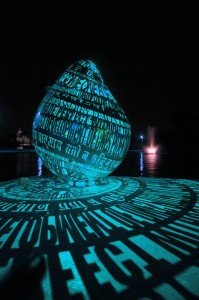[cincopa AcOAMWrOQkpT]
Palo Alto is on the verge of an artistic renaissance.
“Aurora,” the giant interactive willow tree first featured at Burning Man, is due to be unveiled in front of City Hall on Nov. 16 to commence a yearlong residence. Already it has generated buzz among citizens who helped crowdsource the production costs. Artist Charles Gadeken describes his fusion of LED lights and copper leaves that chime in the wind as an attempt to bring “an environment of mythical beauty” to viewers.
Behind the scenes, the city’s seven-person Public Art Commission has been encouraging other projects that cause people to stop, stare, think and talk. Ceevah Sobel’s “Steaming,” an aluminum interpretation of water streams at the East Bayshore Road pump station, and Jeff Petersen’s vibrantly colored mural inside the Children’s Library are offspring of a policy known as Percent for Art. The policy requires that 1 percent of the construction budget for municipal developments go to public art, and the City Council will vote to expand it to private projects.
Joining this growing list are a collection of pieces planned for the Mitchell Park Library and Community Center, “the largest public works project to take place in the City of Palo Alto in 50 years,” according to the commission’s website. With financing from Percent for Art, organizers secured Bay Area artist Bruce Beasley to design the first piece.
Mayor Gregory Scharff, in his State of the City speech this year, emphasized that the power of art comes from its ability to “engage the public.” One upcoming project has taken this to heart. The city commissioned internationally-recognized design duo Joe O’Connell and Blessing Hancock to produce public art for the space between the Main Library and the Art Center. Though Hancock’s Arizona firm, Creative Machines, constructs the pieces off-site, Palo Alto community members contributed to the design process by suggesting quotations in 10 languages for use in sculptures resembling “three-dimensional lantern-like forms.” The languages included Spanish, Sanskrit, Korean and Ohlone (language of the Ohlone Tribe).
“All of the quotes have to do with growth,” said Elise DeMarzo, Palo Alto’s public art program manager. “Artistic growth, biological growth, intellectual growth.”
The call for contributions came with sample phrases such as the Greek definition of life, “to gather,” and a statement from Apple co-founder Steve Jobs: “I would trade all of my technology for an afternoon with Socrates.”
“They are going to animate that space in a really exciting way,” said DeMarzo, who hopes the work will encourage visitors to move fluidly between the library and art center.
Creative Machines has done a successful test-run with some of the commissioned installations near its Arizona studio. “Brilliance,” one of six pieces for the series, has a stainless steel body and measures five feet in height, width and length. It emits a rainbow of LED lighting that reflects concentric circles of language onto its surroundings. “Brilliance,” like “Aurora,” is interactive—curious visitors can use a touch sensor to select which colors are displayed.

The installation date for this “family” of sculptures hinges on the construction schedule of the Main Library, but the art commission anticipates a spring 2014 reveal.
Earlier this year, Scharff and a quartet of council members drafted an internal memo to expedite plans to expand the Percent for Art policy to private developments. The concept is not new to California or even to Palo Alto, which attached the policy to municipal developments in 2005. However, the decision to expand it to include private developments is a first for the city.
In a report to the council’s Policy and Services Committee, city staff members recommended guidelines for which projects would qualify. Any commercial development, addition or reconstruction that takes up “more than 10,000 square feet and [is] valued at $200,000 or more,” should participate, the staff suggested.
According to the report, projects that may meet these requirements include hospitals, libraries and transit stations within the city limits. The Planning Department estimates that public art could receive up to $2 million in new funding.
The Public Art Commission expects some differences between how municipal and private developments will deal with 1 percent of their construction budget going to art. While each project has a unique open-call and artist selection process, DeMarzo said “it was the norm” for municipal projects to pair with established public artists because they “understand the infrastructure required.”
This preference for experienced artists may change if the program moves to include private developments. Future projects could hire more emerging artists than established, depending on the tastes of private developers, she explained.
While the council and the commission have been in talks about enlarging Percent for Art, DeMarzo observed that residents have also approached her about wanting “to see art more engrained and embedded in Palo Alto.” At the Midtown Ice Cream Social in September, a man came up to her and asked ‘Why can’t we have more of that?’
“Clearly he didn’t know,” DeMarzo said, referring to his being outside of the loop on impending plans for the program.
The proposal to expand the existing Percent for Art policy, with added provisos for art maintenance missing from the original policy, requires the official sign-off of Palo Alto’s City Council. A meeting is tentatively slated for Dec. 2.
